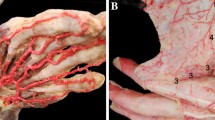Summary
A discussion is presented on the case of a 28-year-old motorcyclist who had an accident and got caught in the spoked wheel of her vehicle. The result was an extensive soft-tissue injury of the metatarsus and calcaneal part of the foot, a defect fracture of the calcaneus, an osseous disinsertion of the Achilles tendon, a lateral malleolus Weber type-A fracture, and a fracture of the second metatarsal bone. The primary treatment consisted in extensive débridement of the strongly contaminated soft parts and refixation of the Achilles tendon on the calcaneus with two osteosynthesis screws. The bruised skin flaps remaining were adapted in a tension-free manner. However, this was possible only in a considerable talipes equinus position. In the further course, the patient developed an extensive skin and soft-tissue necrosis over the calcaneal part of the foot. A neurovascularly pedicled forearm flap was freely grafted in order to maintain the load capacity of the calcaneal part of the foot, to prevent osteitis of the calcaneus, to correct the talipes eqinus position, and to achieve a resensibilization in the load zone of the sole. The healing result was good, and it was possible to achieve extensive correction of the talipes equinus position as well as prevention of calcaneus osteitis; the function of the Achilles tendon was also maintained. Moreover, there was satisfactory resensibilization of the calcaneal part of the foot, so that the patient can now walk in ready-made shoes with a fully molded arch support.
Zusammenfassung
Diskutiert wird der Fall einer 28jährigen Motorradfahrerin, die bei einem Unfall in das Speichenrad ihres Fahrzeuges geraten war. Es resultierte eine ausgedehnte Weichteilverletzung des Mittel- und Rückfußes, eine Defektfraktur des Calcaneus, ein knöcherner Abriß der Achillessehne, eine Außenknöchelfraktur Weber A und eine Metatarsale II-Fraktur. Die Primärversorgung erfolgte in folgender Weise: Ausgedehntes Debridement der stark verschmutzten Weichteile, Refixation der Achillessehne am Calcaneus mit zwei Osteosyntheseschrauben. Die noch erhaltenen, jedoch kontusionierten Hautlappen wurden spannungsfrei adaptiert. Dies war allerdings nur in einer erheblichen Spitzfußstellung möglich. Im weiteren Verlauf kam es zu einer ausgedehnten Haut- und Weichteilnekrose über dem Rückfuß. Um einen belastungsfähigen Rückfuß zu erhalten, eine Calcaneusosteitis abzuwenden, die Spitzfußstellung auszugleichen Bowie eine Resensibilisierung in der Belastungszone der Fußsohle zu erzielen, wurde ein neurovaskulär gestielter Unterarmlappen frei übertragen. Es kam zu einem guten Einheilungsergebnis, die Spitzfußstellung wurde weitgehend ausgeglichen, die Calcaneusosteitis abgewendet, und die Funktion der Achillessehne blieb erhalten. Darüber hinaus kam es zu einer befriedigenden Resensibilisierung des Rückfußes, so daß die Patientin heute in der Lage ist, in Konfektionsschuhen mit einer umfassend gewalkten Einlage zu laufen.
Similar content being viewed by others
References
Daniel RK, Taylor GI (1973) Distant transfer of an island flap by microvascular anastomoses. Plast Reconstr Surg 52:111–117
Daniel RK, Terzis I, Schwarz G (1975) Neurovascular free flaps. Plast Reconstr Surg 56:13–20
Friedebold G, Zilch H, Gaudin B (1979) Fortschritte in der orthopédischen Wiederherstellungschirurgie durch Mikrochirurgie. Z Orthop 117:233–238
Hentz VR, Pearl RM, Kaplan EN (1980) Use of the medial upper arm skin as an arterialized flap. Hand 12:241–247
Jaeger K, Steinau HU, Siebert H, Kühr J (1983) Die Beeinflussung der Osteomyelitis durch freie myocutane Transplantate. Handchirurgie 15:158–163
May JW, Gallico GG, Lukash FN (1982) Microvascular transfer of free tissue for closure of bone wounds of the distal lower extremity. N Engl J Med 306:253–257
Mühlbauer W, Herndl E, Stock W (1982) The forearm flap. Plast Reconstr Surg 70:336–342
Newson HT (1981) Medial arm free flap. Plast Reconstr Surg 67:63–66
Partecke BD, Buck-Gramcko D (1983) Der Unterarmlappen als Insellappen oder freier neurovaskulärer Lappen. Handchirurgie [Suppl] 15:52–56
Partecke BD, Buck-Gramcko D (1984) Der freie Unterarmlappen als Möglichkeit zur gleichzeitigen Wiederherstellung einer geschädigten peripheren Gefäß-Strombahn und der Hautdeckung. Handchir Mikrochir Plast Chir 16:3–6
Partecke BD, Buck-Gramcko D (1985) Deckung von Defekten am Fuß durch einen frei übertragenen Saphenuslappen und dabei aufgetretene Komplikationen. Handchir Mikrochir Plast Chir 17:286–289
Piza-Katzer H, Walzer LR, Rath T (1985) Die Bedeutung der freien mikrovaskulären Gewebsübertragung im Behandlungskonzept schwerer Unterschenkelverletzungen. Acta Chir Australica 5/6:107–115
Ruyao Song (1982) The forearm flap. Discussion. Plast Reconstr Surg 70:343–344
Stock W, Mühlbauer W, Biemer E (1981) Der neurovaskuläre Insellappen. Z Plast Chir 5:158–165
Stock W, Mühlbauer W, Biemer E (1983) Stromumkehr bei Unterarmlappen. Handchirurgie [Suppl] 15:45–48
Stock W, Biemer E, Mühlbauer W (1984) Der Unterarmlappen mit seinen verschiedenen Anwendungsmöglichkeiten. Handchir Mikrochir Plast Chir 16:201–203
Stock W, Biemer E (1984) Sensible Transplantate an der Fußsohle. Handchir Mikrochir Plast Chir 16:215–217
Waris T (1978) Innervation of the skin, skin transplants, flaps and scars. Acta Chir Scand [Suppl] 485
Author information
Authors and Affiliations
Rights and permissions
About this article
Cite this article
Sparmann, M., Ahmadi, A., Kreusch-Brinker, R. et al. The forearm flap as a free neurovascular flap for treatment of an extensive bone/soft-tissue defect in the calcaneal part of the foot. Arch. Orth. Traum. Surg. 106, 263–267 (1987). https://doi.org/10.1007/BF00454330
Received:
Issue Date:
DOI: https://doi.org/10.1007/BF00454330




